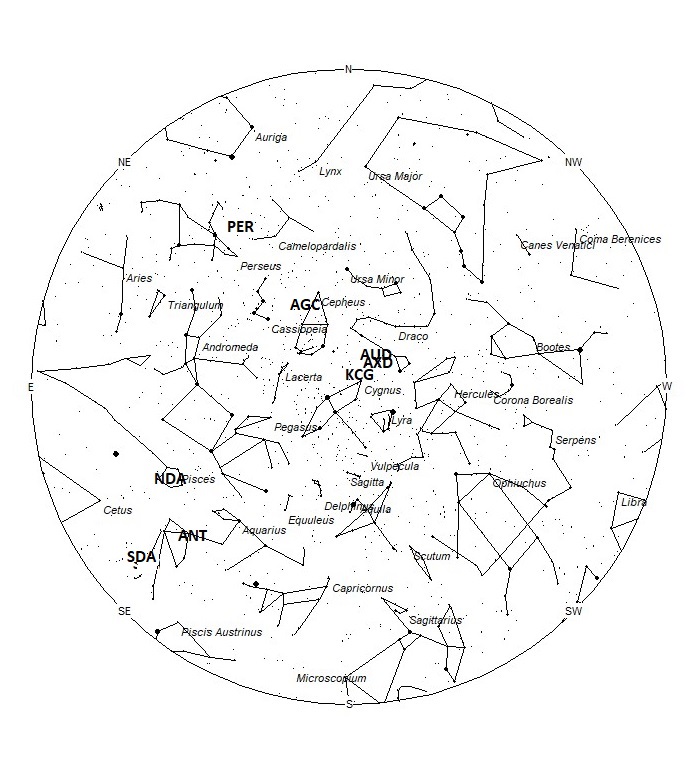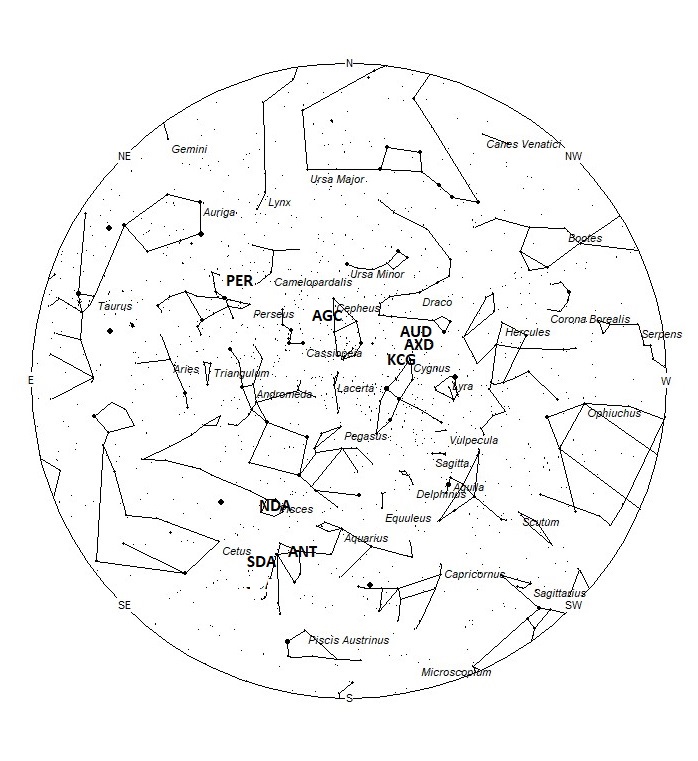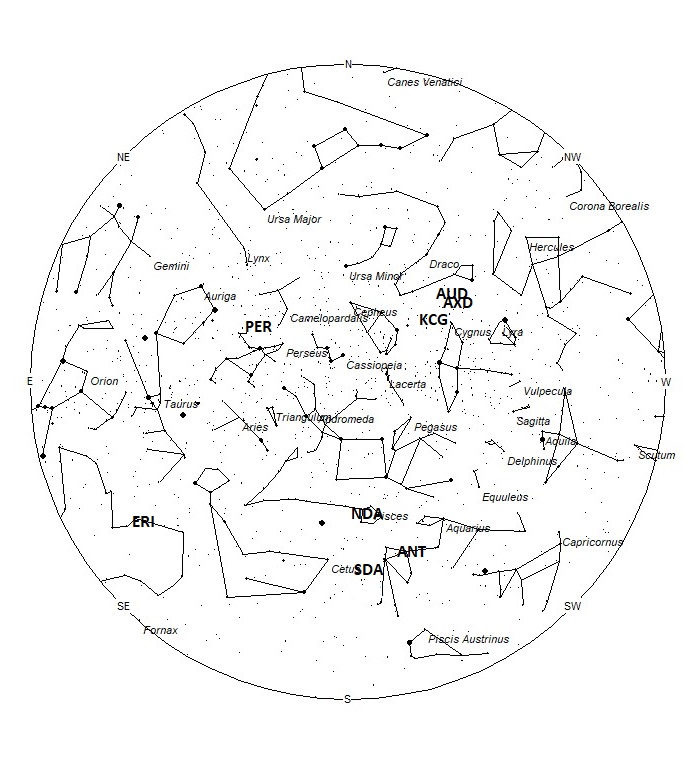During this period, the moon reaches wanes from half illuminated to nearly new. This means the moon will be limited to the morning sky, leaving the evening hours completely clear of moonlight. Toward the end of this period the moon will also be a non-factor in the morning sky as it approached its new phase. The estimated total hourly rates for evening observers this week should be near 5 as seen from mid-northern latitudes (45N) and 4 as seen from tropical southern locations (25S) For morning observers, the estimated total hourly rates should be near 20 as seen from mid-northern latitudes (45N) and 13 as seen from tropical southern locations (25S). The actual rates will also depend on factors such as personal light and motion perception, local weather conditions, alertness, and experience in watching meteor activity. Morning rates are slightly reduced during this period due to moonlight. Note that the hourly rates listed below are estimates as viewed from dark sky sites away from urban light sources. Observers viewing from urban areas will see less activity as only the brighter meteors will be visible from such locations.
The radiant (the area of the sky where meteors appear to shoot from) positions and rates listed below are exact for Saturday night/Sunday morning August 20/21. These positions do not change greatly day to day so the listed coordinates may be used during this entire period. Most star atlases (available at science stores and planetariums) will provide maps with grid lines of the celestial coordinates so that you may find out exactly where these positions are located in the sky. I have also included charts of the sky that display the radiant positions for evening, midnight, and morning. The center of each chart is the sky directly overhead at the appropriate hour. These charts are oriented for facing south but can be used for any direction by rotating the charts to the desired direction. A planisphere or computer planetarium program is also useful in showing the sky at any time of night on any date of the year. Activity from each radiant is best seen when it is positioned highest in the sky, either due north or south along the meridian, depending on your latitude. It must be remembered that meteor activity is rarely seen at the radiant position. Rather they shoot outwards from the radiant, so it is best to center your field of view so that the radiant lies at the edge and not the center. Viewing there will allow you to easily trace the path of each meteor back to the radiant (if it is a shower member) or in another direction if it is sporadic. Meteor activity is not seen from radiants that are located far below the horizon. The positions below are listed in a west to east manner in order of right ascension (celestial longitude). The positions listed first are located further west therefore are accessible earlier in the night while those listed further down the list rise later in the night.
These sources of meteoric activity are expected to be active this week.
.
The zeta Draconids (AUD) and the August xi Draconids (AXD) are both currently active but their radiants lie too close together to be separated by visual means. The AXD’s currently lie at 18:07 (272) +60 while the AUD’s lie at 18:17 (274) +62. These positions are located roughly 4 degrees northeast of the 4th magnitude star known as Grumium (xi Draconis). The combined hourly rates are still less than 1, so little activity can be expected from these sources. To best see these meteors, face half-way up in the northern sky near 2100 Local Summer Time (LST), when it lies on the meridian and is located highest in the sky. Both of these sources produce slow meteors with an entry velocity of 21 km/sec.
The kappa Cygnids (KCG) are active from August 1-27, with maximum occurring on the 14th. The radiant is currently located at 19:19 (290) +56. This area of the sky is located in on the Cygnus/Draco border, 3 degrees north of the 4th magnitude star known as kappa Cygni. To best see these meteors face half-way up in the northern sky near near 2200 LST when it lies on the meridian and is located highest in the sky. With a high northern declination, these meteors are difficult to view from the southern hemisphere. Expected hourly rates this week are less than 1 no matter your location. With an entry velocity of 23 km/sec., the average meteor from this source would be of slow velocity.
The large Anthelion (ANT) radiant is currently centered at 22:44 (341) -08. This position lies in northern Aquarius, 1 degree west of the 4th magnitude star known as Hydor (lambda Aquarii). Rates at this time should be near 2 per hour no matter your location. Observers concentrating on this activity should face half-way up in the southern sky near 02:00 LST to best view these meteors. With an entry velocity of 30 km/sec., the average Anthelion meteor would be of slow velocity.
The August beta Piscids (NDA) are part of the Northern delta Aquariid complex, active from August 18-September 8. This second peak of the NDA’s occurs on August 21st, when the radiant lies well within the boundaries of the constellation of Pisces. The radiant currently lies at 23:30 (353) +04, which is located in western Pisces, 3 degrees south of the 4th magnitude star known as theta Piscium. To best see these meteors, face half-way up in the southern sky near 0300 LST, when it lies on the meridian and is located highest in the sky. Hourly rates at this time should be less than 1 no matter your location. With an entry velocity of 38 km/sec., the average meteor from this source would be of medium velocity.
The last of the Southern delta Aquariids (SDA) may be seen from a radiant located at 23:39 (355) -13. This area of the sky is located in southwestern Aquarius, 2 degrees northwest of the 4th magnitude star known as Omega2 Aquarii. Hourly rates at this time should be less than 1 no matter your location. Observers concentrating on this activity should face half-way up in the southern sky near 03:00 LST to best view these meteors. With an entry velocity of 36 km/sec., the average meteor from this source would be of medium velocity.
The August gamma Cepheids (AGC) are a recent discovery by Damir Šegon and the Croatian Meteor Network team based on studying SonotaCo and CMN observations (SonotaCo 2007-2011, CMN 2007-2010). Meteors from this source are expected from August 17 through September 6, with maximum activity occurring on August 29. The current position lies at 23:48 (357) +74, which lies in northern Cepheus, 4 degrees south of the 3rd magnitude star known as Errai (gamma Cephei A). To best see these meteors, face half-way up toward the north near 0300 LST, when it lies on the meridian and is located highest in the sky. Rates at this time should be less than 1 per hour as no matter your location. With an entry velocity of 43 km/sec., the average meteor would be of medium velocity. These meteors are not visible south of latitude 20 South.
The eta Eridanids (ERI) were discovered by the Tokyo Meteor Network back in 2001. The radiant is currently located near 03:32 (053) -09. This position lies in northern Eridanus, near the spot occupied by the 4th magnitude star known as Ran (epsilon Eridani). This source is active until September 10th, with maximum activity occurring on August 6th. Current rates would be near 1 per hour no matter your location. Observers concentrating on this activity should face high up in the southeastern sky during the last dark hour prior to dawn to best view these meteors. With an entry velocity of 64 km/sec., the average meteor from this source would be of swift speed.
The Perseids (PER) are still active from a radiant located at 04:00 (060) +59. This position lies in southern Camelopardalis, 10 degrees northeast of the 2nd magnitude star known as Mirfak (alpha Persei). Current rates are expected to be near 5 per hour as seen from the Northern Hemisphere and 1 as seen from southern tropical locations. Observers concentrating on this activity should face half-way up in the northerneastern sky during the last dark hour prior to dawn to best view these meteors. Observers in the northern hemisphere are better situated to view this activity as the radiant rises much higher in the sky before dawn compared to southern latitudes. With an entry velocity of 59 km/sec., the average meteor from this source would be of swift velocity.
As seen from the mid-northern hemisphere (45N) one would expect to see approximately 12 sporadic meteors per hour during the last hour before dawn as seen from rural observing sites. Evening rates would be near 4 per hour. As seen from the tropical southern latitudes (25S), morning rates would be near 7 per hour as seen from rural observing sites and 3 per hour during the evening hours. Locations between these two extremes would see activity between the listed figures. Morning rates are slightly reduced due to moonlight.
You can keep track of the activity of these meteor showers as well as those beyond the limits of visual observing by visiting the NASA Meteor Shower Portal available at: https://meteorshowers.seti.org/ You can move the sky globe to see different areas of the sky. Colored dots indicate shower meteors while white dots indicate sporadic (random) activity. The large orange disk indicates the position of the sun so little activity will be seen in that area of the sky.
The list below offers the information from above in tabular form. Rates and positions are exact for Saturday night/Sunday morning except where noted in the shower descriptions.
| SHOWER | DATE OF MAXIMUM ACTIVITY | CELESTIAL POSITION | ENTRY VELOCITY | CULMINATION | HOURLY RATE | CLASS |
| RA (RA in Deg.) DEC | Km/Sec | Local Summer Time | North-South | |||
| August xi Draconids (AXD) | Aug 15 | 18:07 (272) +60 | 21 | 21:00 | <1 – <1 | IV |
| zeta Draconids (AUD) | Aug 26 | 18:17 (274) +62 | 21 | 21:00 | <1 – <1 | IV |
| kappa Cygnids (KCG) | Aug 14 | 19:19 (290) +56 | 23 | 22:00 | <1 – <1 | II |
| Anthelion (ANT) | – | 22:44 (341) -08 | 30 | 02:00 | 2 – 2 | II |
| August beta Piscids (NDA) | Aug 12 | 23:30 (353) +04 | 38 | 03:00 | <1 – <1 | IV |
| Southern delta Aquariids (SDA) | Jul 31 | 23:39 (355) -13 | 38 | 03:00 | <1 – <1 | I |
| August gamma Cepheids (AGC) | Aug 29 | 23:48 (357) +74 | 43 | 03:00 | <1 – <1 | IV |
| eta Eridanids (ERI) | Aug 06 | 03:32 (053) -09 | 64 | 07:00 | 1 – 1 | II |
| Perseids (PER) | Aug 13 | 04:00 (060) +59 | 59 | 07:00 | 5 – 2 | I |




